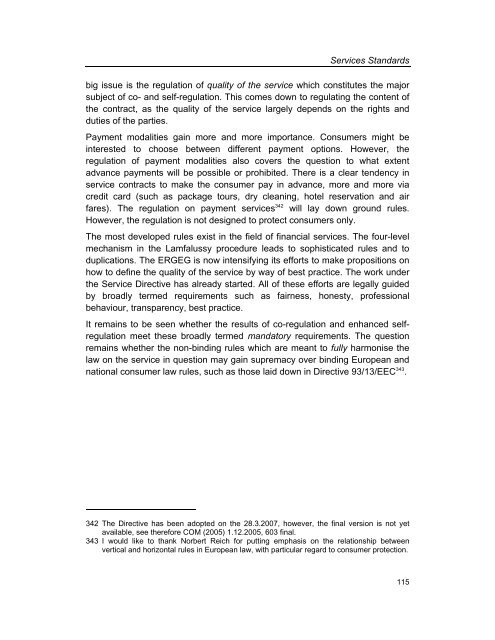Services Standards: Defining the Core Consumer Elements ... - ANEC
Services Standards: Defining the Core Consumer Elements ... - ANEC
Services Standards: Defining the Core Consumer Elements ... - ANEC
Create successful ePaper yourself
Turn your PDF publications into a flip-book with our unique Google optimized e-Paper software.
<strong>Services</strong> <strong>Standards</strong><br />
big issue is <strong>the</strong> regulation of quality of <strong>the</strong> service which constitutes <strong>the</strong> major<br />
subject of co- and self-regulation. This comes down to regulating <strong>the</strong> content of<br />
<strong>the</strong> contract, as <strong>the</strong> quality of <strong>the</strong> service largely depends on <strong>the</strong> rights and<br />
duties of <strong>the</strong> parties.<br />
Payment modalities gain more and more importance. <strong>Consumer</strong>s might be<br />
interested to choose between different payment options. However, <strong>the</strong><br />
regulation of payment modalities also covers <strong>the</strong> question to what extent<br />
advance payments will be possible or prohibited. There is a clear tendency in<br />
service contracts to make <strong>the</strong> consumer pay in advance, more and more via<br />
credit card (such as package tours, dry cleaning, hotel reservation and air<br />
fares). The regulation on payment services 342 will lay down ground rules.<br />
However, <strong>the</strong> regulation is not designed to protect consumers only.<br />
The most developed rules exist in <strong>the</strong> field of financial services. The four-level<br />
mechanism in <strong>the</strong> Lamfalussy procedure leads to sophisticated rules and to<br />
duplications. The ERGEG is now intensifying its efforts to make propositions on<br />
how to define <strong>the</strong> quality of <strong>the</strong> service by way of best practice. The work under<br />
<strong>the</strong> Service Directive has already started. All of <strong>the</strong>se efforts are legally guided<br />
by broadly termed requirements such as fairness, honesty, professional<br />
behaviour, transparency, best practice.<br />
It remains to be seen whe<strong>the</strong>r <strong>the</strong> results of co-regulation and enhanced selfregulation<br />
meet <strong>the</strong>se broadly termed mandatory requirements. The question<br />
remains whe<strong>the</strong>r <strong>the</strong> non-binding rules which are meant to fully harmonise <strong>the</strong><br />
law on <strong>the</strong> service in question may gain supremacy over binding European and<br />
national consumer law rules, such as those laid down in Directive 93/13/EEC 343 .<br />
342 The Directive has been adopted on <strong>the</strong> 28.3.2007, however, <strong>the</strong> final version is not yet<br />
available, see <strong>the</strong>refore COM (2005) 1.12.2005, 603 final.<br />
343 I would like to thank Norbert Reich for putting emphasis on <strong>the</strong> relationship between<br />
vertical and horizontal rules in European law, with particular regard to consumer protection.<br />
115
















